Using a Rotating 3D LiDAR on a Mobile Robot for Estimation of Person’s Body Angle and Gender
Abstract
1. Introduction
2. Related Work
2.1. 3D LiDAR Sensing Technology
2.2. Using Mobile 3D LiDARs
2.3. Detecting Human Features Based on Depth Data
2.4. Using Simulations for Learning
3. Collecting Datasets
3.1. Velodyne HDL-32E LiDAR
3.2. Obtaining People Point Clouds from LiDAR Data
3.3. Datasets
- Artificially created LiDAR dataset (simulated dataset, Section 3.3.1)
- LiDAR data collected in a laboratory environment (lab dataset, Section 3.3.2)
3.3.1. Simulated Dataset
3.3.2. Lab Dataset
3.3.3. Real World Dataset
4. Estimation of Features
4.1. Mapping of Point Clouds to 2D Images
4.2. Convolutional Neural Networks for Estimation
4.3. Sequential Bayesian Estimation
5. Results
5.1. Evaluation Procedure
5.2. Estimation of the Body Angle
5.3. Estimation of Gender
6. Discussion
6.1. Velodyne HDL-32E for Estimating Features
6.2. Training on Artificial Data
6.3. Generalizability to Different LiDARs
Author Contributions
Funding
Acknowledgments
Conflicts of Interest
References
- Karunarathne, D.; Morales, Y.; Kanda, T.; Ishiguro, H. Understanding a public environment via continuous robot observations. Robot. Auton. Syst. 2020, 126, 103443. [Google Scholar] [CrossRef]
- Mizumaru, K.; Satake, S.; Kanda, T.; Ono, T. Stop doing it! Approaching strategy for a robot to admonish pedestrians. In Proceedings of the 2019 14th ACM/IEEE International Conference on Human-Robot Interaction (HRI), Daegu, Korea, 11–14 March 2019; pp. 449–457. [Google Scholar]
- Munaro, M.; Menegatti, E. Fast RGB-D people tracking for service robots. Auton. Robot. 2014, 37, 227–242. [Google Scholar] [CrossRef]
- Liu, K.; Li, Y. New patent maps to visualize worldwide patent strength of competitors on LiDAR system. J. Multidiscip. Eng. Sci. Stud. 2020, 6, 3094–3098. [Google Scholar]
- Li, Y.; Ibanez-Guzman, J. Lidar for autonomous driving: The principles, challenges, and trends for automotive lidar and perception systems. arXiv 2020, arXiv:2004.08467. [Google Scholar] [CrossRef]
- Yoo, H.W.; Druml, N.; Brunner, D.; Schwarzl, C.; Thurner, T.; Hennecke, M.; Schitter, G. MEMS-based lidar for autonomous driving. e & i Elektrotechnik Und Informationstechnik 2018, 135, 408–415. [Google Scholar]
- Hokuyo YVT-35LX 3D Scanning Range Finder. Available online: https://www.hokuyo-aut.jp/search/single.php?serial=224 (accessed on 12 July 2020).
- Amzajerdian, F.; Roback, V.E.; Bulyshev, A.; Brewster, P.F.; Hines, G.D. Imaging flash lidar for autonomous safe landing and spacecraft proximity operation. In Proceedings of the AIAA Space and Astronautics Forum and Exposition (SPACE 2016), Long Beach, CA, USA, 12–15 September 2016; p. 5591. [Google Scholar]
- Eldada, L.; Yu, T.; Pacala, A. Optical Phased Array Lidar System and Method of Using Same. US Patent 10,126,412, 13 November 2018. [Google Scholar]
- Zhang, J.; Singh, S. LOAM: Lidar odometry and mapping in real-time. In Proceedings of the Robotics: Science and Systems Conference (RSS), Berkeley, CA, USA, 12–16 July 2014. [Google Scholar]
- Moosmann, F.; Stiller, C. Velodyne slam. In Proceedings of the 2011 IEEE Intelligent Vehicles Symposium (IV), Baden-Baden, Germany, 5–9 June 2011; pp. 393–398. [Google Scholar]
- Nüchter, A.; Lingemann, K.; Hertzberg, J.; Surmann, H. 6D SLAM—3D mapping outdoor environments. J. Field Robot. 2007, 24, 699–722. [Google Scholar] [CrossRef]
- Thrun, S.; Burgard, W.; Fox, D. Probabilistic Robotics; MIT Press: Cambridge, MA, USA, 2000. [Google Scholar]
- Che, E.; Jung, J.; Olsen, M.J. Object recognition, segmentation, and classification of mobile laser scanning point clouds: A state of the art review. Sensors 2019, 19, 810. [Google Scholar] [CrossRef] [PubMed]
- Arnold, E.; Al-Jarrah, O.Y.; Dianati, M.; Fallah, S.; Oxtoby, D.; Mouzakitis, A. A survey on 3d object detection methods for autonomous driving applications. IEEE Trans. Intell. Transp. Syst. 2019, 20, 3782–3795. [Google Scholar] [CrossRef]
- Li, Y.; Ma, L.; Zhong, Z.; Liu, F.; Cao, D.; Li, J.; Chapman, M.A. Deep Learning for LiDAR Point Clouds in Autonomous Driving: A Review. arXiv 2020, arXiv:2005.09830. [Google Scholar]
- Chen, X.; Ma, H.; Wan, J.; Li, B.; Xia, T. Multi-view 3d object detection network for autonomous driving. In Proceedings of the IEEE Conference on Computer Vision and Pattern Recognition (CVPR), Honolulu, HI, USA, 21–26 July 2017; pp. 1907–1915. [Google Scholar]
- Oh, S.I.; Kang, H.B. Object detection and classification by decision-level fusion for intelligent vehicle systems. Sensors 2017, 17, 207. [Google Scholar] [CrossRef] [PubMed]
- Wang, Z.; Zhan, W.; Tomizuka, M. Fusing bird’s eye view lidar point cloud and front view camera image for 3d object detection. In Proceedings of the 2018 IEEE Intelligent Vehicles Symposium (IV), Changshu, China, 26–30 June 2018; pp. 1–6. [Google Scholar]
- Kidono, K.; Miyasaka, T.; Watanabe, A.; Naito, T.; Miura, J. Pedestrian recognition using high-definition LIDAR. In Proceedings of the 2011 IEEE Intelligent Vehicles Symposium (IV), Baden-Baden, Germany, 5–9 June 2011; pp. 405–410. [Google Scholar]
- Li, K.; Wang, X.; Xu, Y.; Wang, J. Density enhancement-based long-range pedestrian detection using 3-D range data. IEEE Trans. Intell. Transp. Syst. 2015, 17, 1368–1380. [Google Scholar] [CrossRef]
- Navarro, P.J.; Fernandez, C.; Borraz, R.; Alonso, D. A machine learning approach to pedestrian detection for autonomous vehicles using high-definition 3D range data. Sensors 2017, 17, 18. [Google Scholar] [CrossRef] [PubMed]
- Yan, Z.; Duckett, T.; Bellotto, N. Online learning for 3D LiDAR-based human detection: Experimental analysis of point cloud clustering and classification methods. Auton. Robot. 2020, 44, 147–164. [Google Scholar] [CrossRef]
- Patil, A.; Malla, S.; Gang, H.; Chen, Y.T. The H3D dataset for full-surround 3d multi-object detection and tracking in crowded urban scenes. In Proceedings of the 2019 IEEE International Conference on Robotics and Automation (ICRA), Montreal, QC, Canada, 20–24 May 2019; pp. 9552–9557. [Google Scholar]
- Chang, M.F.; Lambert, J.; Sangkloy, P.; Singh, J.; Bak, S.; Hartnett, A.; Wang, D.; Carr, P.; Lucey, S.; Ramanan, D.; et al. Argoverse: 3D tracking and forecasting with rich maps. In Proceedings of the IEEE Conference on Computer Vision and Pattern Recognition (CVPR), Long Beach, CA, USA, 16–20 June 2019; pp. 8748–8757. [Google Scholar]
- Sun, P.; Kretzschmar, H.; Dotiwalla, X.; Chouard, A.; Patnaik, V.; Tsui, P.; Guo, J.; Zhou, Y.; Chai, Y.; Caine, B.; et al. Scalability in perception for autonomous driving: Waymo open dataset. In Proceedings of the IEEE/CVF Conference on Computer Vision and Pattern Recognition (CVPR), 14–19 June 2020; pp. 2446–2454. [Google Scholar]
- Carballo, A.; Lambert, J.; Monrroy, A.; Wong, D.; Narksri, P.; Kitsukawa, Y.; Takeuchi, E.; Kato, S.; Takeda, K. LIBRE: The multiple 3d lidar dataset. arXiv 2020, arXiv:2003.06129. [Google Scholar]
- Spinello, L.; Luber, M.; Arras, K.O. Tracking people in 3D using a bottom-up top-down detector. In Proceedings of the 2011 IEEE International Conference on Robotics and Automation (ICRA), Shanghai, China, 9–13 May 2011; pp. 1304–1310. [Google Scholar]
- Häselich, M.; Jöbgen, B.; Wojke, N.; Hedrich, J.; Paulus, D. Confidence-based pedestrian tracking in unstructured environments using 3D laser distance measurements. In Proceedings of the 2014 IEEE/RSJ International Conference on Intelligent Robots and Systems, Chicago, IL, USA, 14–18 September 2014; pp. 4118–4123. [Google Scholar]
- Kinect for Windows. Available online: https://developer.microsoft.com/en-us/windows/kinect/ (accessed on 28 May 2020).
- Spinello, L.; Arras, K.O. People detection in RGB-D data. In Proceedings of the 2011 IEEE/RSJ International Conference on Intelligent Robots and Systems, San Francisco, CA, USA, 25–30 September 2011; pp. 3838–3843. [Google Scholar]
- Luber, M.; Spinello, L.; Arras, K.O. People tracking in RGB-D data with on-line boosted target models. In Proceedings of the 2011 IEEE/RSJ International Conference on Intelligent Robots and Systems, San Francisco, CA, USA, 25–30 September 2011; pp. 3844–3849. [Google Scholar]
- Brščić, D.; Kanda, T.; Ikeda, T.; Miyashita, T. Person tracking in large public spaces using 3-D range sensors. IEEE Trans. Hum. Mach. Syst. 2013, 43, 522–534. [Google Scholar] [CrossRef]
- Linder, T.; Wehner, S.; Arras, K.O. Real-time full-body human gender recognition in (RGB)-D data. In Proceedings of the 2015 IEEE International Conference on Robotics and Automation (ICRA), Seattle, WA, USA, 26–30 May 2015; pp. 3039–3045. [Google Scholar]
- Linder, T.; Arras, K.O. Real-time full-body human attribute classification in RGB-D using a tessellation boosting approach. In Proceedings of the 2015 IEEE/RSJ International Conference on Intelligent Robots and Systems (IROS), Hamburg, Germany, 28 September–2 October 2015; pp. 1335–1341. [Google Scholar]
- Kollmitz, M.; Eitel, A.; Vasquez, A.; Burgard, W. Deep 3D perception of people and their mobility aids. Robot. Auton. Syst. 2019, 114, 29–40. [Google Scholar] [CrossRef]
- Zimmermann, C.; Welschehold, T.; Dornhege, C.; Burgard, W.; Brox, T. 3d human pose estimation in rgbd images for robotic task learning. In Proceedings of the 2018 IEEE International Conference on Robotics and Automation (ICRA), Brisbane, QLD, Australia, 21–25 May 2018; pp. 1986–1992. [Google Scholar]
- Shotton, J.; Fitzgibbon, A.; Cook, M.; Sharp, T.; Finocchio, M.; Moore, R.; Kipman, A.; Blake, A. Real-time human pose recognition in parts from single depth images. In Proceedings of the IEEE Conference on Computer Vision and Pattern Recognition (CVPR), Providence, RI, USA, 20–25 June 2011; pp. 1297–1304. [Google Scholar]
- Lewandowski, B.; Seichter, D.; Wengefeld, T.; Pfennig, L.; Drumm, H.; Gross, H.M. Deep orientation: Fast and robust upper body orientation estimation for mobile robotic applications. In Proceedings of the 2019 IEEE/RSJ International Conference on Intelligent Robots and Systems (IROS), Venetian Macao, Macau, China, 3–8 November 2019; pp. 441–448. [Google Scholar]
- Teichman, A.; Levinson, J.; Thrun, S. Towards 3D object recognition via classification of arbitrary object tracks. In Proceedings of the 2011 IEEE International Conference on Robotics and Automation (ICRA), Shanghai, China, 9–13 May2011; pp. 4034–4041. [Google Scholar]
- Wang, D.Z.; Posner, I.; Newman, P. What could move? In Finding cars, pedestrians and bicyclists in 3D laser data. In Proceedings of the 2012 IEEE International Conference on Robotics and Automation (ICRA), Saint Paul, MN, USA, 14–18 May 2012; pp. 4038–4044. [Google Scholar]
- Zhao, J.; Xu, H.; Liu, H.; Wu, J.; Zheng, Y.; Wu, D. Detection and tracking of pedestrians and vehicles using roadside LiDAR sensors. Transp. Res. Part Emerg. Technol. 2019, 100, 68–87. [Google Scholar] [CrossRef]
- Varol, G.; Romero, J.; Martin, X.; Mahmood, N.; Black, M.J.; Laptev, I.; Schmid, C. Learning from synthetic humans. In Proceedings of the IEEE Conference on Computer Vision and Pattern Recognition (CVPR), Honolulu, HI, USA, 21–26 July 2017; pp. 109–117. [Google Scholar]
- Malik, J.; Elhayek, A.; Nunnari, F.; Varanasi, K.; Tamaddon, K.; Heloir, A.; Stricker, D. Deephps: End-to-end estimation of 3d hand pose and shape by learning from synthetic depth. In Proceedings of the 2018 International Conference on 3D Vision (3DV), Verona, Italy, 5–8 September 2018; pp. 110–119. [Google Scholar]
- Velodyne HDL-32E. Available online: https://velodynelidar.com/products/hdl-32e/ (accessed on 28 May 2020).
- Satake, S.; Kaczmarek, T.; Brščić, D.; Kanda, T. Facilitating software development for mobile social robots by simulating interactions between a robot and pedestrians. In Proceedings of the 2019 14th ACM/IEEE International Conference on Human-Robot Interaction (HRI), Daegu, Korea, 11–14 March 2019; pp. 626–627. [Google Scholar]
- The MORSE Simulator. Available online: https://www.openrobots.org/morse/ (accessed on 28 May 2020).
- Willems, J.; Corbetta, A.; Menkovski, V.; Toschi, F. Pedestrian orientation dynamics from high-fidelity measurements. arXiv 2020, arXiv:2001.04646. [Google Scholar] [CrossRef]
- Goodfellow, I.; Bengio, Y.; Courville, A. Deep Learning; MIT Press: Cambridge, MA, USA, 2016. [Google Scholar]
- Mirnig, N.; Stollnberger, G.; Miksch, M.; Stadler, S.; Giuliani, M.; Tscheligi, M. To err is robot: How humans assess and act toward an erroneous social robot. Front. Robot. AI 2017, 4, 21. [Google Scholar] [CrossRef]
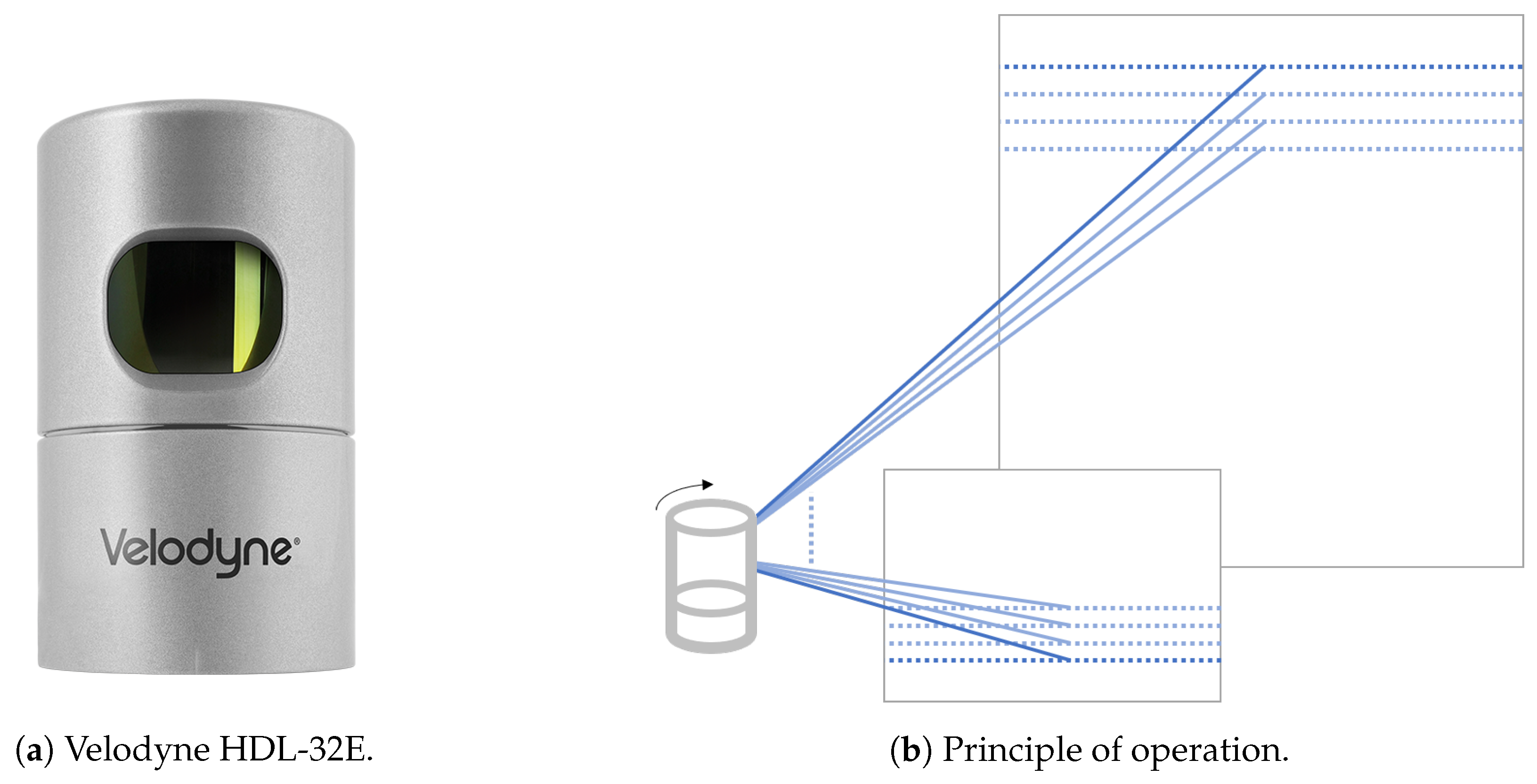
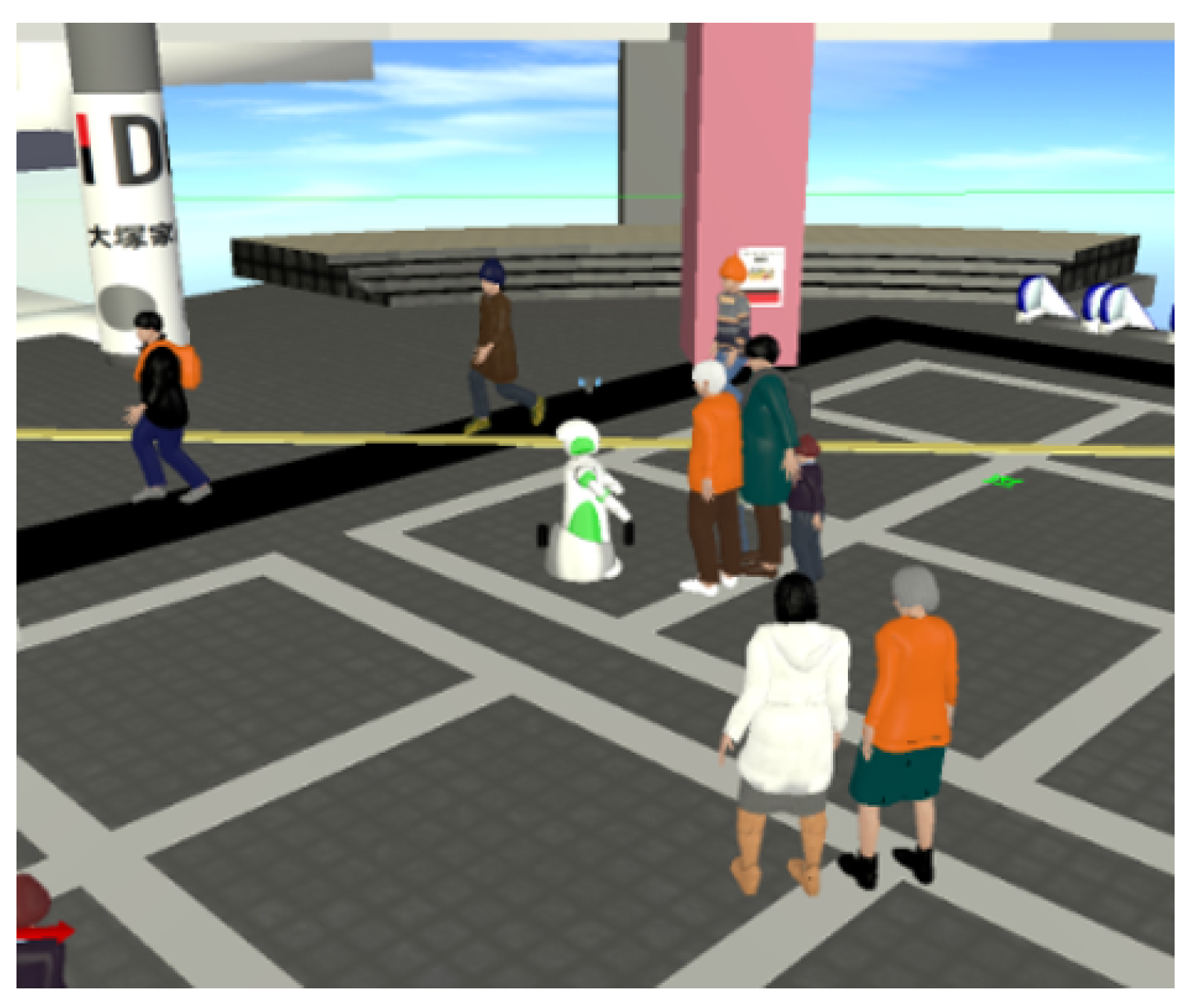
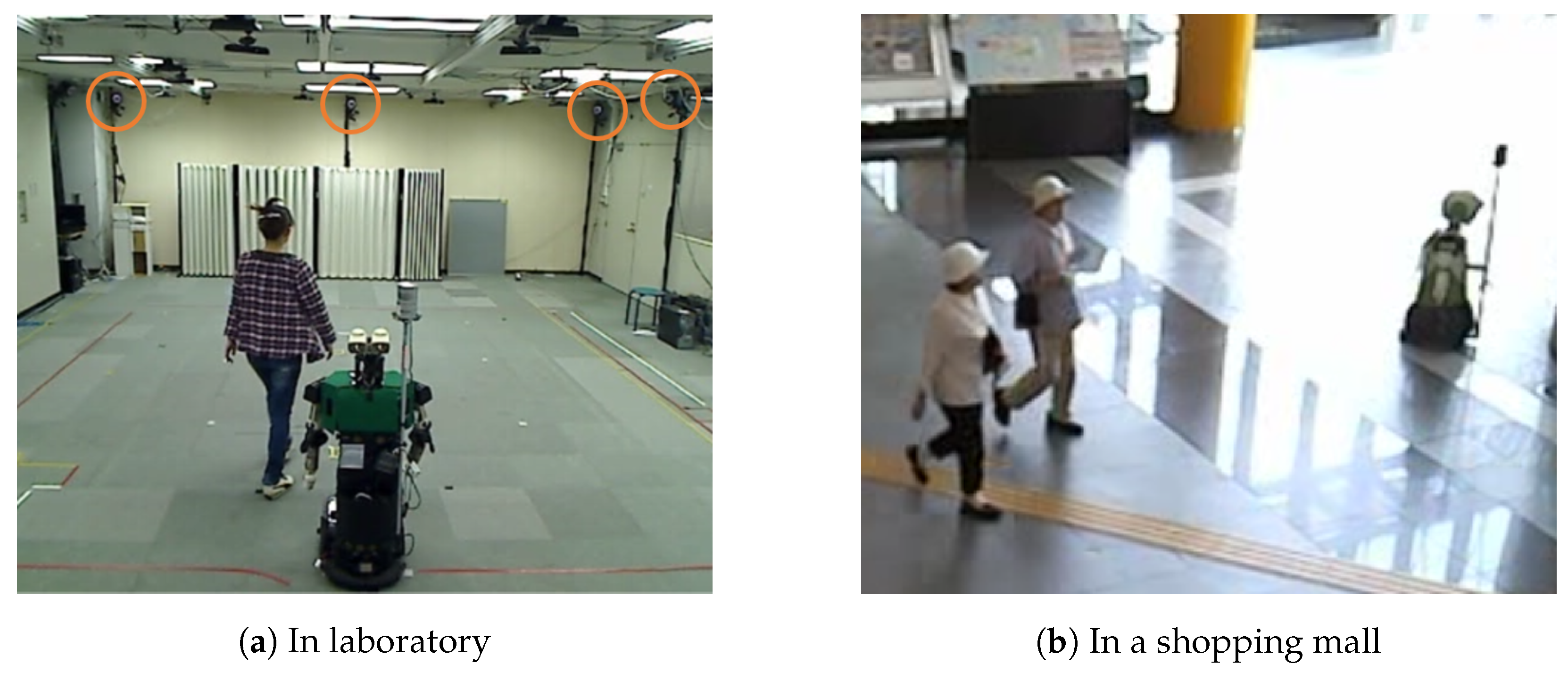


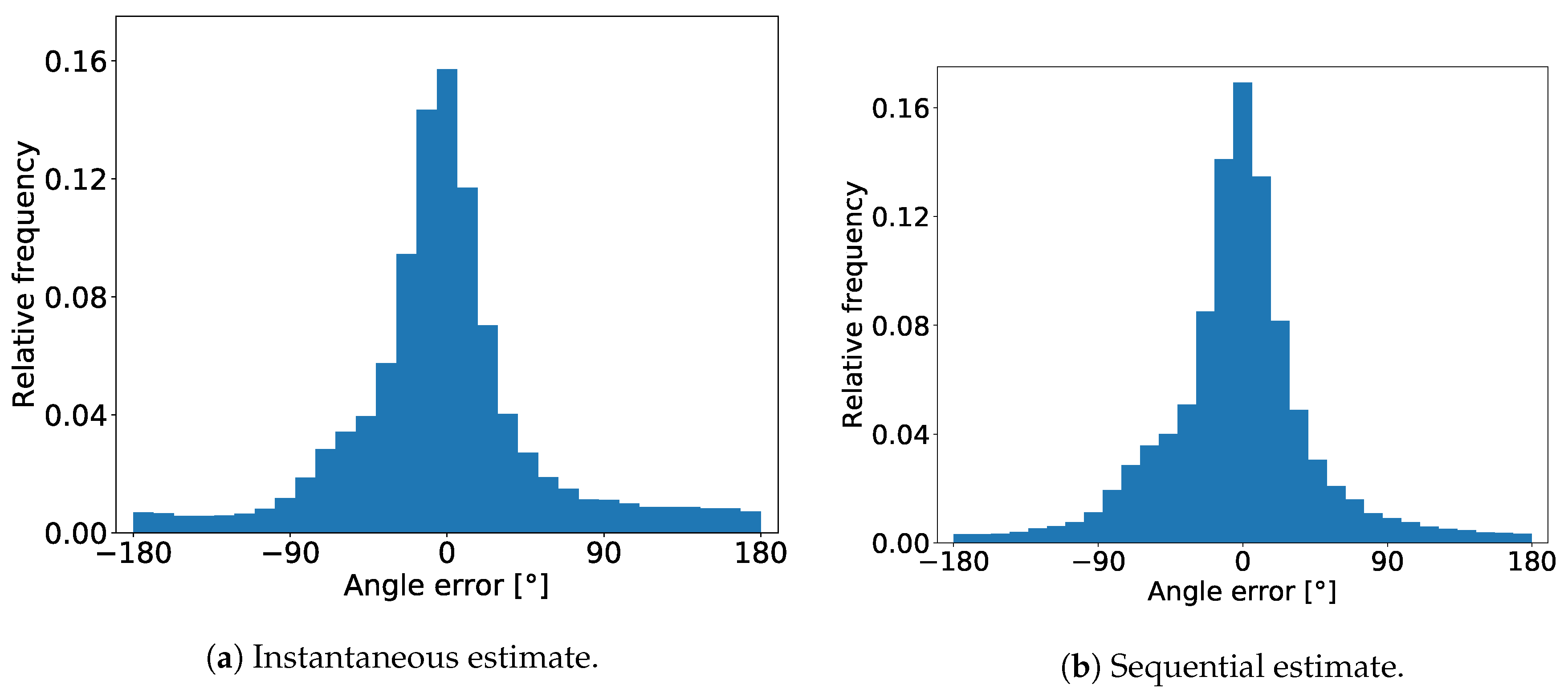
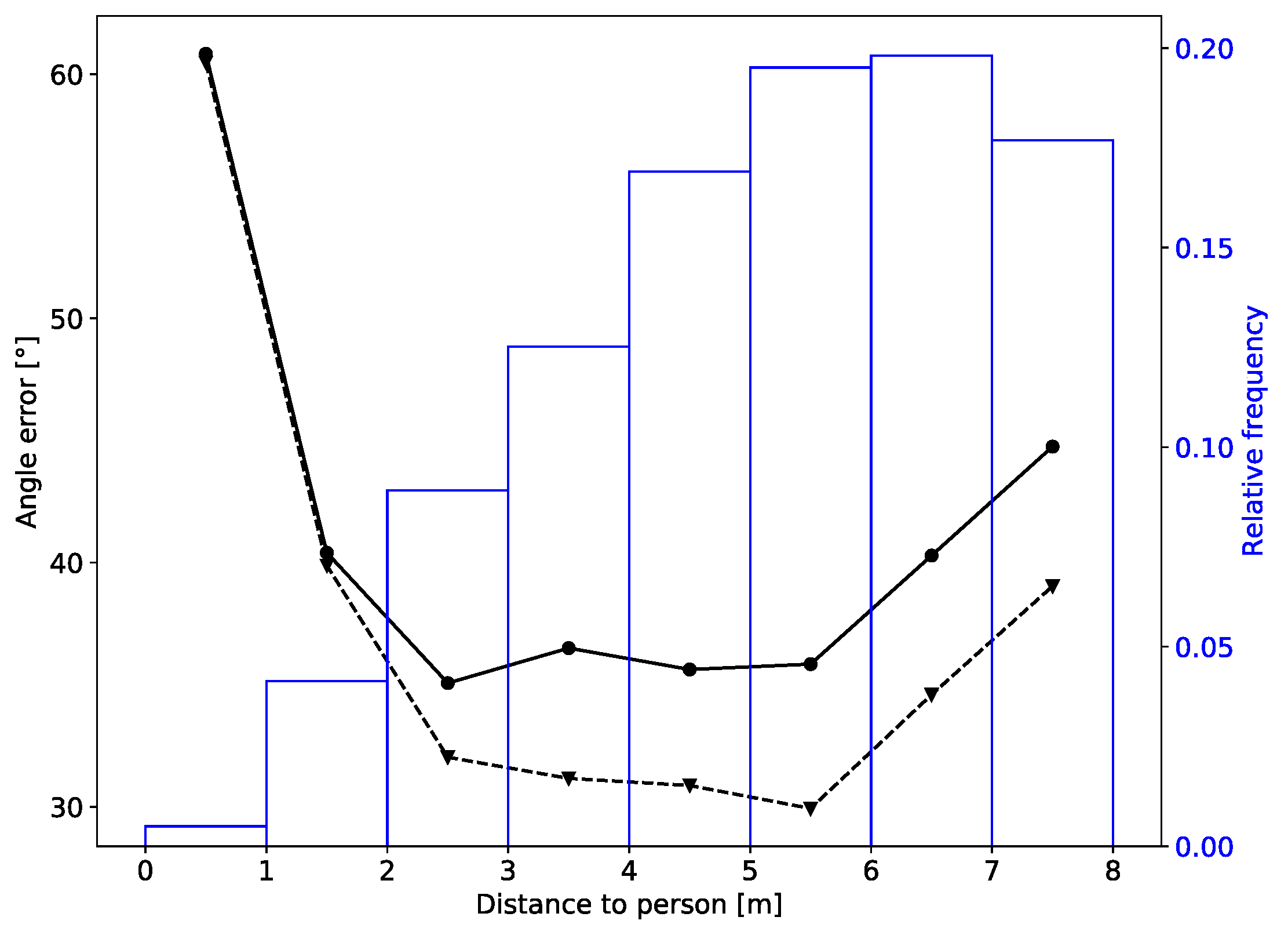
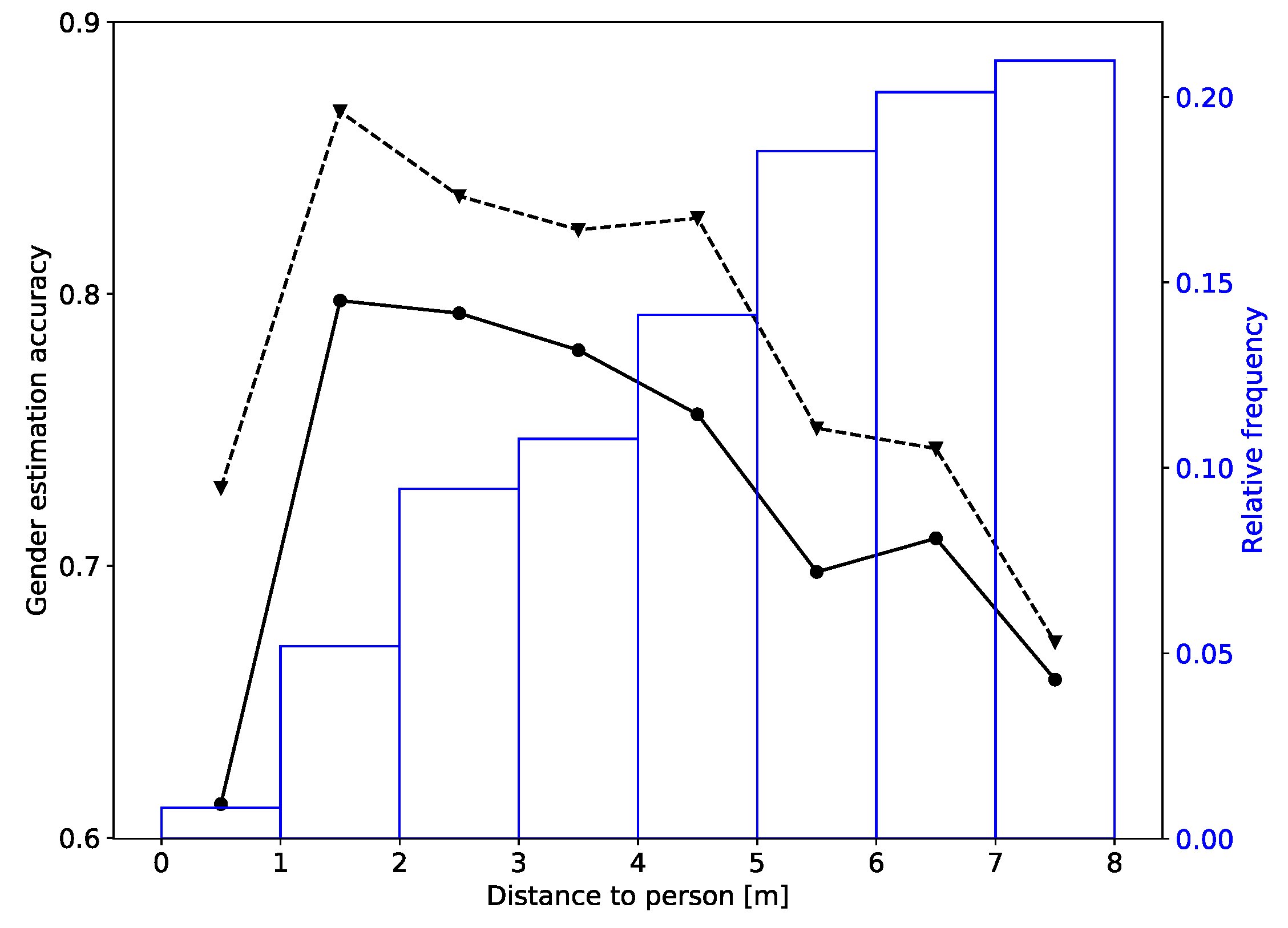

| Testing Data | Lab | Real World | |||
|---|---|---|---|---|---|
| Instantaneous | Sequential | Instantaneous | Sequential | ||
| Training data | Simulated | 26.01 | 26.78 | 40.88 | 35.46 |
| Lab | - | - | 47.35 | 39.23 | |
| Simulated + Lab | - | - | 38.59 | 33.53 | |
| Real World | - | - | 41.41 | 41.18 | |
| Testing Data | Lab | Real World | |||
|---|---|---|---|---|---|
| Instantaneous | Sequential | Instantaneous | Sequential | ||
| Training data | Simulated | 0.7543 | 0.7407 | 0.5383 | 0.5559 |
| Lab | 0.6559 | 0.6817 | |||
| Simulated + Lab | - | - | 0.6099 | 0.6513 | |
| Real World | - | - | 0.7224 | 0.7653 | |
© 2020 by the authors. Licensee MDPI, Basel, Switzerland. This article is an open access article distributed under the terms and conditions of the Creative Commons Attribution (CC BY) license (http://creativecommons.org/licenses/by/4.0/).
Share and Cite
Brščić, D.; Evans, R.W.; Rehm, M.; Kanda, T. Using a Rotating 3D LiDAR on a Mobile Robot for Estimation of Person’s Body Angle and Gender. Sensors 2020, 20, 3964. https://doi.org/10.3390/s20143964
Brščić D, Evans RW, Rehm M, Kanda T. Using a Rotating 3D LiDAR on a Mobile Robot for Estimation of Person’s Body Angle and Gender. Sensors. 2020; 20(14):3964. https://doi.org/10.3390/s20143964
Chicago/Turabian StyleBrščić, Dražen, Rhys Wyn Evans, Matthias Rehm, and Takayuki Kanda. 2020. "Using a Rotating 3D LiDAR on a Mobile Robot for Estimation of Person’s Body Angle and Gender" Sensors 20, no. 14: 3964. https://doi.org/10.3390/s20143964
APA StyleBrščić, D., Evans, R. W., Rehm, M., & Kanda, T. (2020). Using a Rotating 3D LiDAR on a Mobile Robot for Estimation of Person’s Body Angle and Gender. Sensors, 20(14), 3964. https://doi.org/10.3390/s20143964





